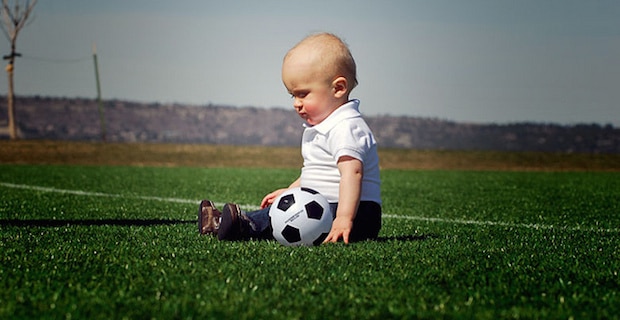
Use of artificial turf for sports fields and playgrounds in schools and day care centers is popular because the grass-like material not only looks like natural grass, it also can be a significant cost saver. Artificial turf does not need to be mowed, weeded, fertilized, or watered, and it also provides an all-weather playing surface that can take a beating. One problem however, is that kids who play on artificial turf may be taking a beating when it comes to their health.
Artificial turf (aka synthetic turf) is a multilayered product that typically has a granular filler layer composed of sand and/or pellets of recycled tires or other materials that provide resiliency, stability, and uniformity. The artificial turf products that are raising the concerns of some individuals are those that use the recycled rubber (aka crumb rubber) because there are toxic substances in those tires.
Back in late 2014, NBC News triggered heightened public awareness of the potential dangers of crumb rubber turf when it broadcast reports on the topic. The news was prompted by a soccer coach and former players who asked the federal government to investigate the possible link between exposure to fields that use this turf and the development of cancer.
Crumb rubber contains about 30 components that have toxic and cancer-causing properties. Along with the possibility of increased risk of skin infection, injury, and cancer from exposure to artificial turf, there’s the added worry that young children may ingest lead from the synthetic materials. Some of the other toxins in crumb rubber include arsenic, benzene, mercury, and toluene.
Read more about toxic chemicals and children's health
Artificial turf study
In a study published in the Journal of Toxicology and Environmental Health, a team evaluated five synthetic turf fields that used crumb rubber in Connecticut for health hazards. The study looked at four outdoor and one indoor synthetic turf field during the summer. Nearly two dozen chemicals “of potential concern” were found and assessed. The scientists found that both cancer and noncancer risk levels reached or were below levels of concern. Children who played on the indoor field were at most risk of exposure, “suggesting a potential concern.”
The chemical that was named as contributing the most to this concern was benzothiazole, a semivolatile organic chemical that was 14-fold higher on the indoor field when compared with the outdoor fields. These findings were similar to those uncovered in previous studies, and the authors suggested that building operators should provide sufficient ventilation at indoor fields that use artificial turf.
Artificial turf debate
The Synthetic Turf Association, however, argues that artificial turf is safe and lists a number of studies by different organizations that came to that conclusion. For example:
- The California Office of Environmental Health Hazard Assessment finished a study in October 2010 and reported that the air quality above outdoor artificial turf that used crumb rubber raised no public health concerns regarding lead, other heavy metals, and volatile organic compounds (VOCs).
- In the same year, the Connecticut Department of Public Health reported that a study of the health risks to kids and adults who were exposed to artificial turf fields had “not elevated health risks.”
- A December 2009 report from the US Environmental Protection Agency (EPA) noted that their tests of synthetic turf and crumb rubber regarding inhalation, skin contact, and ingestion showed levels that were “below levels of concern.” However, this report only looked at four sites and a limited number of substances. The EPA admitted that “it is not possible to extend the results beyond the four study sites or to reach any more comprehensive conclusions without the consideration of additional data.”
- The US Consumer Product Safety Commission (CPSC) announced in July 2008 that it approved of the use of artificial turf for children and individuals of all ages.
However, the Consumer Product Safety Commission recently (April 2015) announced that it had reconsidered its belief that artificial turf was safe for children. In a news report dated April 30, 2015, the agency’s Communications Director, Scott Wolfson, stated that “Chairman Elliot Kaye has deep concerns with the (2008) press release and it is not the agency’s current position. What was done in 2008 was not good enough to make a claim either way as to the safety of those fields.” Wolfson noted that the agency is not pursuing any studies at this time because of cost constraints.
Read about heavy metals and kids’ health
In addition, a number of studies mentioned in a recent USA Today article noted that “at least 10 studies since 2007-including those by the safety commission [Consumer Product Safety Commission] and the EPA [Environmental Protection Agency]-have found potentially harmful lead levels in turf fibers and in rubber crumbs.” Lead exposure is associated with developmental delay, learning difficulties, aggressive behavior, nausea, abdominal pain, fatigue, headache, and more.
The battle over artificial turf safety is in full swing. It’s a fight between the strong lobbyists from the Synthetic Turf Association claiming their manufacturers do not make products that are a health hazard and a variety of agencies and researchers whose study results are in conflict. Clearly more investigations need to be done by impartial parties.
In the middle are concerned parents of young children who may be exposed to potentially harmful playgrounds and athletic fields that contain crumb rubber. Individuals can question school administrators and public officials about the type of artificial turf being used in their areas and push for testing and/or replacement should the turf prove to contain crumb rubber and hazardous substances.
Image: Sergio Vassio Photography










